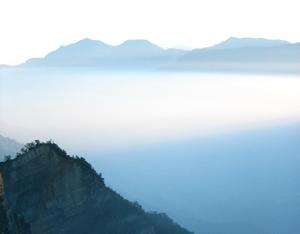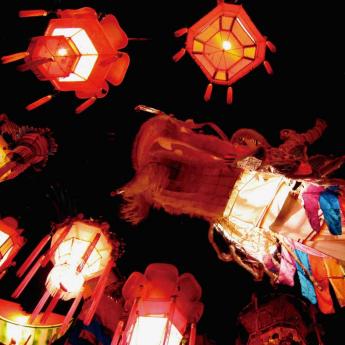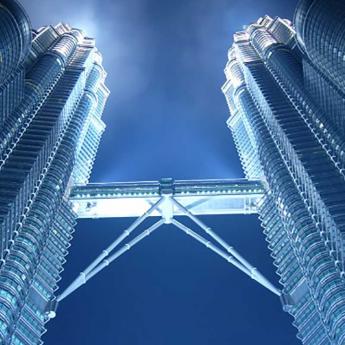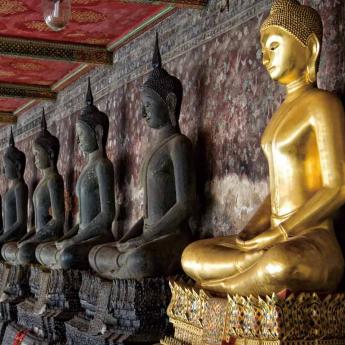A Night and Day on Alishan (Part 1 of 2)
Sunrise
Every story should start with a sunrise. Though I arrived at Alishan (Mt. Ali) late in the evening, the sunrise I watched early the next morning will always come first in my memories.
To watch the sunrise on Alishan, you must be prepared to catch transportation in the pre-dawn morning; sometimes the train departs as early as 4:00 a.m., as sunrise falls between 5:25 and 6:20 a.m. depending on the time of year. A roundtrip on the Chushan Train costs NT$150, and most hotels have a bus to take guests to the train station free-of-charge. At the Alishan Guest House, the bus schedule is posted in the lobby and you can rent a heavy coat (highly recommended) for around NT$100 at the main reservation desk.
Cold, groggy from sleep, but quietly excited, I nestled myself into a seat on the bus and then a few minutes later, shuffled into the train station and onto the train with the rest of the crowd going to see the sunrise. At the lookout point, people vied for the best spot to take a photo of the rising sun, which emerges from behind two peaks of Yushan (Mt. Jade), the tallest mountain of Taiwan.
While waiting for the sun to appear, I listened to the tour guide explain that during the Japanese occupation of Taiwan, Yushan frustrated the Japanese when they discovered it was, at 3,952 m, taller than their own beloved Mt. Fuji, 3,776 m. To give Yushan its due, they renamed it "New High Mountain."
Pre-dawn, I thought the most beautiful scenery could be found northeast of Yushan, where mist hung in front of the Central Mountain Range, colors of plum and maroon fog billowed in the valley beneath a sky slowly lightening from Prussian blue to a watery gray. In the foreground, the silhouette of a bare tree drew crooked black lines through the abstract colors. It was the kind of scenery that convinces dreamers to write poetry and poets to continue dreaming.
Focused on the scenery in the northeast, I would have missed the sunrise completely if my tour guide had not called my name and pointed to the dark peaks of Yushan.
My view of Yushan was limited because of the crowd. I gently pressed my way as close to the front of the crowd as I could. Struggling to hold my camera steady and still keep my warm coat wrapped around me, I poised one foot on the edge of the barrier and tried not jostle any of the photographers surrounding me. A ray of light appeared, and everyone sucked in their breath.
Before that moment, I hadn't watched a sunrise in a long time. Another ray of light appeared, and I thought about putting down my camera for a second, just till I could see the top slice of the sun. I'm glad I didn't. Though the sun rises slowly, the moment when the actual Sun appears in the sky-whether on a beach, beyond the horizon of your own hometown, or on a distant mountaintop-happens in an instant. The chain of events moves directly from "the sun is rising" to "the sun has risen"; the sun does not strike a pose.
Everyone snapped pictures, everyone clapped, and then people wandered off into groups to explore other parts of the vantage point. What we'd waited half an hour for in the cold and dark had come and gone in a matter of two or three seconds. But I didn't feel disappointed. I felt satisfied, awake, and, after two or three minutes, warm enough to take off my heavy coat. Amazing how quickly the sun warms everything once it rises. The mist in the northeastern valley was gone.
As we made our way back down to the train station, we stopped to sample honey and wasabi at vendor stalls. The stalls had not been there on our way up to the viewpoint; they had set up while we were all waiting for the sun to rise. It made me realize that having free time to wait for the sun to rise was an incredible luxury we had all shared that morning. How many other people were like the vendors, up before dawn, working in such close proximity to where something incredible happened every morning? Did they ever sneak up there to enjoy the sunrise, too, or had they seen it so many times that it had lost its value?
Background on Alishan
Alishan National Forest Recreation Area (also called National Scenic Area) lies in Chiayi County in western Taiwan. The area received official protected status in March 2001. This protected area includes surrounding villages of Ruili, Fengshan Taihe, Dabang, Shanmei, and Chashan. It is believed that this area was used as hunting grounds by tribal Jou people around 250 years ago, and one story says that the people so greatly respected their chief, Abali, that they decided to name their hunting grounds after him. The official scenic area encompasses 1,400 hectares.
There are about sixteen hotels within the forest recreation area, many offering transportation to the train station and coat rental as Alishan Guest House did. Average cost for a double room is NT $2,000-$2,800, though you may find discounts for weekdays. Reservations are recommended. Information on hotels, history, and activities can be found on the official Alishan National Scenic Area Web site.
Alishan National Scenic Area
http://www.ali.org.tw/en/intro/intro1.php
* * * * *
 ThingsAsian
ThingsAsian













